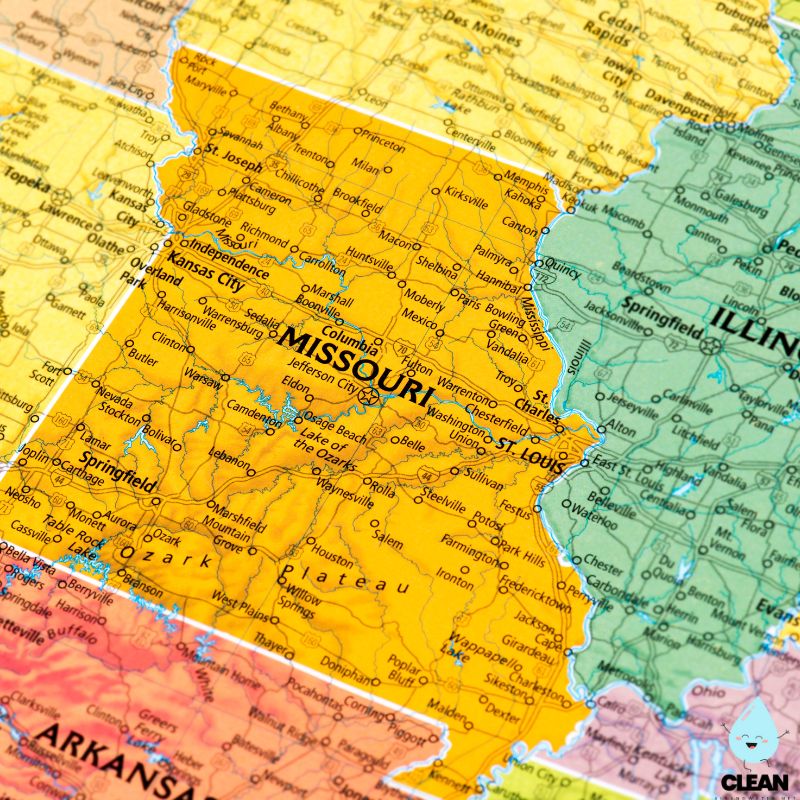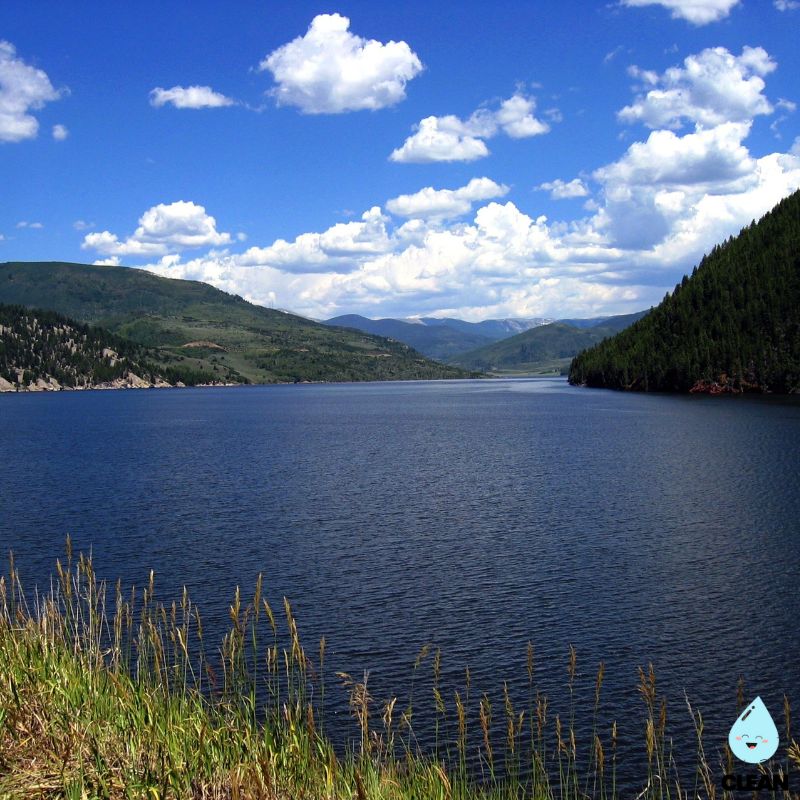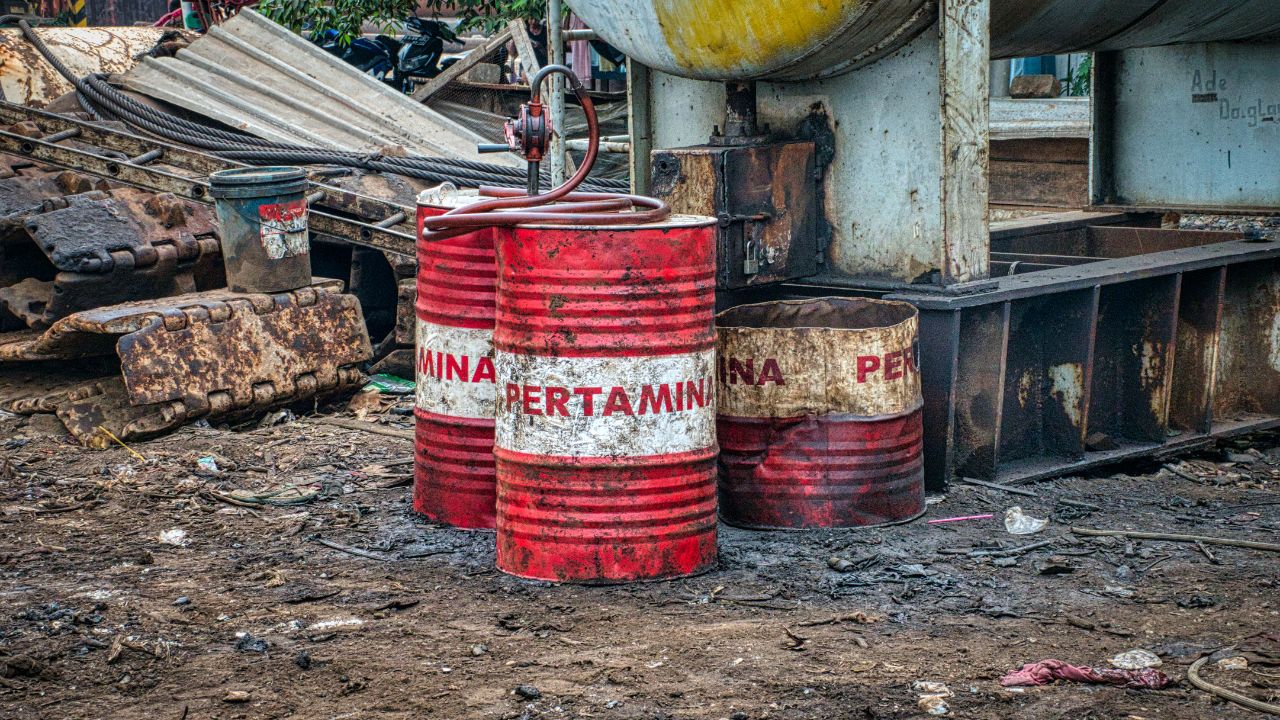Missouri Water Quality at a Glance
emerging concerns
Is Missouri Water Safe to Drink?
Generally Yes, With Growing Caution – Most Missouri water systems meet federal standards, but PFAS contamination is emerging at military bases and near industrial sites. Key concerns include chromium-6 levels 63x higher than health guidelines in St. Louis and disinfection byproducts from treatment processes. Springfield utilities are actively diluting PFAS-contaminated sources, and the state is proactively testing 76% of public water systems ahead of federal requirements.
⚠️ Key Concerns for Missouri Residents
- PFAS “Forever Chemicals”: Detected at Whiteman AFB, Richards-Gebaur AFB; Springfield diluting James River water sources; state testing 76% of population
- Military Base Impact: Firefighting foam (AFFF) contamination at multiple Missouri military installations affecting groundwater
- Chromium-6: St. Louis tap water averages 1,600 ppt (63x higher than health guidelines); Kansas City also shows elevated levels
- Disinfection Byproducts: High trihalomethanes and haloacetic acids in major cities from Missouri/Mississippi River treatment processes
Read the full report below for detailed analysis, city-specific data, and actionable recommendations for Missouri residents.
Missouri – Gateway to Water Innovation – Water Quality Report 2025: PFAS Testing, Infrastructure Concerns & Safety across your state
Missouri’s water infrastructure serves approximately 6.2 million residents across diverse geographical regions, from the Missouri River valley in the north to the Ozark Plateau in the south. The state operates through a complex network of public water systems, with Missouri American Water being the largest utility serving approximately 1.6 million people, alongside numerous municipal utilities and smaller rural systems. Missouri’s abundant water resources include the Missouri and Mississippi river systems, thousands of miles of streams and lakes, and extensive groundwater aquifers that supply both urban centers and agricultural communities.
Despite Missouri’s substantial water resources, the state faces significant infrastructure challenges. According to the American Society of Civil Engineers’ Infrastructure Report Card, Missouri’s water infrastructure faces aging system challenges with ongoing concerns about funding shortfalls. The state has received over $429 million in total federal infrastructure investments from the Biden-Harris Administration’s Bipartisan Infrastructure Law since 2022 to address these challenges, focusing on drinking water safety, wastewater treatment upgrades, and emerging contaminant removal including PFAS “forever chemicals.” Missouri’s commitment to water quality improvement is demonstrated through partnerships between the Missouri Department of Natural Resources (MoDNR), local utilities, and federal agencies working to ensure safe, reliable water access for all residents.

Missouri Water Quality: Current Status (2024-2025)
Statewide Compliance and Testing
- Overall Compliance: The majority of Missouri’s public water systems meet federal Safe Drinking Water Act standards, with Missouri American Water serving 1.6 million people and consistently meeting or surpassing all state and federal water quality regulations for all regulated substances, including lead.
- PFAS Monitoring: Missouri has conducted voluntary PFAS sampling since 2013, representing public water supplies serving more than 76% of the state’s population (approximately 4.7 million people), with most cities showing low levels of four types of PFAS according to MoDNR databases.
- Infrastructure Investment: Over $429 million in total federal funding through the Bipartisan Infrastructure Law has been allocated to Missouri since 2022 for water infrastructure improvements, including specific funding for emerging contaminant treatment and disadvantaged communities.
Major Water Sources and Challenges
- Missouri River System: Primary water source for much of northern and central Missouri, including Kansas City and Columbia areas, requiring ongoing monitoring for agricultural runoff and emerging contaminants including PFAS detection and mitigation efforts.
- Mississippi River Basin: Serves St. Louis metropolitan area and eastern Missouri communities, with documented challenges from urban runoff and legacy industrial contamination requiring advanced treatment technologies for contaminants including chromium-6 levels averaging 1,600 parts per trillion.
- Aging Infrastructure Concerns: Kansas City experienced a record 1,844 water main breaks in 2012, while St. Louis deals with similar issues with water mains averaging 55 to 65 years of age, requiring an estimated $8.5 billion in infrastructure investments over 20 years according to EPA assessments.
Emerging Contaminant Response
- PFAS Regulation Implementation: New EPA drinking water standards for PFOA and PFOS (4 parts per trillion) take effect in 2029, with Missouri planning proactive sampling for all community water systems by 2025, two years ahead of federal requirements through MoDNR’s comprehensive monitoring program.
- Treatment Technology Deployment: Water utilities are implementing advanced treatment technologies including activated carbon filtration and reverse osmosis systems, with systems like Springfield already blending PFAS-contaminated sources from the James River with clean water to reduce contaminant levels.
- PFAS Workgroup Initiative: MoDNR has established a stakeholder workgroup with Missouri experts in wastewater, stormwater, drinking water, chemistry, and environmental advocacy to address emerging contaminant concerns comprehensively and develop state-specific policies.
Rural and Disadvantaged Communities
- Infrastructure Disparities: Rural water systems face disproportionate challenges with aging infrastructure, limited technical capacity, and higher per-capita costs for compliance with new emerging contaminant regulations, particularly PFAS treatment requirements.
- Targeted Federal Support: Communities with less than 10,000 people and disadvantaged conditions are eligible for federal grants to purchase sampling equipment and monitor water for emerging contaminants, though ongoing operational costs for treatment systems remain a challenge.
- Technical Assistance Programs: MoDNR and EPA provide enhanced technical support to help smaller systems navigate complex regulatory requirements and secure funding for necessary improvements through state revolving fund programs and competitive grant opportunities.
Looking Forward: 2025-2030
Missouri’s water quality landscape is undergoing significant transformation as utilities prepare for new federal PFAS regulations taking effect in 2029. The state’s proactive approach to PFAS monitoring, combined with substantial federal infrastructure investments totaling over $429 million since 2022, positions Missouri as a leader in addressing emerging water quality challenges. However, successful implementation will require continued collaboration between state regulators, water utilities, and communities to ensure that all Missourians have access to safe, affordable drinking water while addressing the estimated $8.5 billion in infrastructure needs and legacy contamination including chromium-6 and disinfection byproducts that have historically challenged the state’s water systems.
Recommendations for Missouri Residents

Know Your Water Source
Contact your water utility to request annual water quality reports and ask about PFAS testing results. Visit MoDNR’s Missouri PFAS Viewer Tool to access your local system’s testing data and understand any contaminants of concern in your area, particularly for chromium-6 and disinfection byproducts.

Support Infrastructure Investment
Stay informed about local water infrastructure needs and support utility rate structures that enable necessary improvements. Attend public meetings when utilities discuss infrastructure upgrades and PFAS treatment investments, understanding that aging systems require significant funding.

Consider PFAS-Certified Filtration
For areas with known PFAS contamination or high chromium-6 levels (particularly in St. Louis), consider NSF-certified activated carbon or reverse osmosis filters specifically tested for PFAS and heavy metal removal. These can provide additional protection while utilities implement treatment upgrades.

Report Water Quality Concerns
Contact your local water utility immediately for taste, odor, or color concerns. Report suspected contamination to MoDNR’s Office of Communications at (573) 751-1010 for investigation and follow-up. Kansas City residents should call 311 or (816) 513-1313 for water main breaks or service issues.

Practice Water Conservation
Support Missouri’s water sustainability by implementing conservation measures like efficient irrigation, rainwater harvesting, and low-flow fixtures. Reducing demand helps utilities maintain system reliability and affordability while reducing strain on aging infrastructure.
Missouri Cities We Cover
Kansas City Water Quality
Comprehensive analysis of Kansas City’s water infrastructure, treatment processes, and quality monitoring. Includes information on Missouri River water sources, system reliability improvements following the record 1,844 water main breaks in 2012, and ongoing PFAS monitoring programs.
St. Louis Water Quality
Detailed assessment of St. Louis metropolitan area water systems, covering water quality testing including chromium-6 monitoring, infrastructure modernization for aging systems averaging 55-65 years, and compliance with emerging contaminant regulations in Missouri’s largest metropolitan area.
Frequently Asked Questions
Is Missouri’s tap water safe to drink?
Most of Missouri’s public water systems meet federal drinking water standards and are safe for consumption. Missouri American Water, the state’s largest utility, consistently meets or surpasses all regulations for regulated substances including lead.
The Missouri Department of Natural Resources requires comprehensive testing across all public water systems. Voluntary PFAS sampling has been conducted since 2013, representing water supplies serving more than 76% of Missouri’s population (approximately 4.7 million people), with most systems showing low levels of PFAS chemicals. However, some areas face specific concerns including chromium-6 contamination in St. Louis and disinfection byproducts from treatment processes. Water utilities are implementing advanced treatment technologies and the state has received over $429 million in federal funding since 2022 to address emerging contaminants and infrastructure needs. Residents should review their utility’s annual water quality report and stay informed about local conditions.
What are PFAS chemicals and why are they a concern in Missouri?
PFAS (per- and polyfluoroalkyl substances) are synthetic “forever chemicals” that don’t break down naturally in the environment or human body, with detected contamination at military bases including Whiteman Air Force Base.
Missouri has been monitoring PFAS since 2013 and has detected levels requiring mitigation in some water systems, such as Springfield’s James River source which utilities are diluting with clean water. These chemicals have been linked to cancer, liver damage, immune system effects, and other health concerns. The EPA finalized new drinking water standards in 2024 limiting PFOA and PFOS to 4 parts per trillion, requiring water systems to comply by 2029. Missouri is ahead of federal requirements, planning to have all community water systems sample for PFAS by 2025, two years early. The state has established a PFAS workgroup with experts to address these emerging contaminants comprehensively and is receiving federal funding for treatment technologies.
How can I find out about my local water quality?
Missouri residents can access comprehensive water quality information through several resources:
• Annual Water Quality Reports: Contact your water utility directly for their Consumer Confidence Report, which details all testing results and any violations or concerns
• Missouri PFAS Viewer Tool: Visit the Missouri Department of Natural Resources’ interactive map to access PFAS testing data for your local water system
• MoDNR Database: Access water quality testing results and compliance information through the state’s online database system
• EWG Tap Water Database: Use your zip code to search for contaminants detected in your local water system and get filter recommendations for specific contaminants like chromium-6
Why does Missouri have water infrastructure challenges?
Missouri’s water infrastructure faces several interconnected challenges:
Aging Systems: Many water systems were built decades ago and need modernization, with Kansas City experiencing a record 1,844 main breaks in 2012 and St. Louis having water mains averaging 55-65 years old
Funding Requirements: The EPA estimated Missouri’s 20-year water infrastructure needs at $8.5 billion, requiring substantial investment in system upgrades and maintenance
Rural Challenges: Smaller, rural water systems face higher per-capita costs and limited technical capacity to implement complex treatment technologies for emerging contaminants like PFAS
Regulatory Barriers: State requirements for voter approval to raise revenue and issue bonds create challenges for utilities seeking to fund necessary improvements
The state is addressing these challenges through federal infrastructure investments totaling over $429 million since 2022, improved planning, and partnerships with utilities to prioritize the most critical improvements.
Quality News About Your Water
Get the comprehensive water quality news coverage you need with our dedicated US Water News Service. From coast to coast, we deliver in-depth reporting and expert analysis on PFAS contamination, EPA regulatory changes, infrastructure developments, and emerging water safety issues affecting communities nationwide. While mainstream media only covers the biggest stories, we provide the detailed, ongoing coverage that helps you understand the full scope of America’s water challenges. Whether you’re a concerned citizen, water professional, or community leader, our daily updates and analytical insights keep you informed about the issues that matter most to public health and environmental safety.
Contaminants of Concern

PFAS “Forever Chemicals”
Source: Industrial manufacturing, firefighting foam (AFFF) use at airports and military installations including Whiteman Air Force Base and Richards-Gebaur Air Force Base, consumer products including non-stick cookware and stain-resistant textiles, potential releases from manufacturing facilities
Health Effects: Linked to kidney and testicular cancer, liver damage, immune system suppression, high cholesterol, thyroid disease, and ulcerative colitis according to CDC and EPA studies
Current Status: Most Missouri cities show low levels of four types of PFAS according to MoDNR databases, with proactive monitoring covering 76% of the state’s population (4.7 million people). Springfield is actively diluting James River sources containing PFOS. EPA Limits: 4 ppt for PFOA and PFOS individually, with hazard index requirements for other PFAS compounds taking effect in 2029

Chromium-6 and Disinfection Byproducts
Source: Industrial pollution and natural occurrence in mineral deposits affecting groundwater, particularly in St. Louis area where levels average 1,600 parts per trillion. Disinfection byproducts form when chlorine treatment reacts with organic matter in Missouri and Mississippi River water sources
Health Effects: Chromium-6 is a known carcinogen linked to cancer. Trihalomethanes and haloacetic acids (disinfection byproducts) increase cancer risk and may cause problems during pregnancy, with elevated levels detected in Kansas City and St. Louis water systems
Current Status: St. Louis shows chromium-6 levels 63 times higher than health guidelines. Kansas City and St. Louis exceed EWG recommendations for disinfection byproducts due to river water treatment processes. Regulatory Response: No federal limits for chromium-6; California set 0.02 ppb goal. Disinfection byproducts regulated under federal Safe Drinking Water Act
Please read – our information
The information presented on cleanairandwater.net is compiled from official water quality reports, trusted news sources, government websites, and public health resources. While we strive for accuracy and thoroughness in our presentations, we are not scientists, engineers, or qualified water quality professionals.
Our mission is to present water quality information in an accessible, real-world format that helps people understand what’s in their water and make informed decisions about their health and safety. We believe that complex environmental information should be available to everyone in a format that’s easy to understand.
We make every effort to ensure our content is current and accurate, but we cannot guarantee that all information is complete or error-free. This website should not replace official communications from your local water utility or health department. We always recommend consulting official sources for the most up-to-date information regarding your specific water system.
Clean Air and Water is not liable for any unintentional errors, omissions, or outdated information. The content on this site is provided for informational purposes only and should not be considered professional advice.


